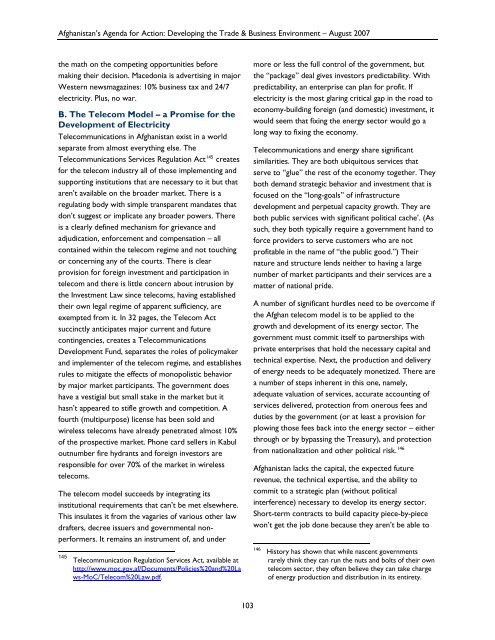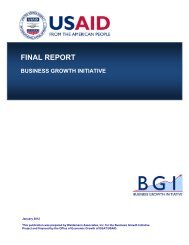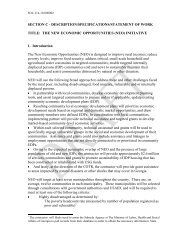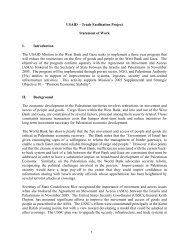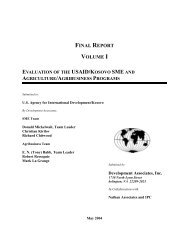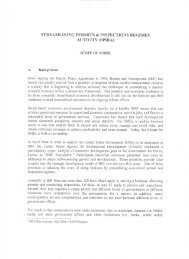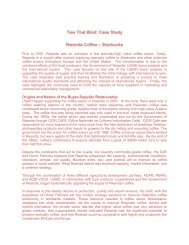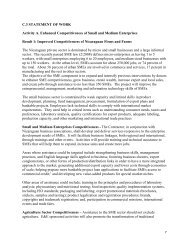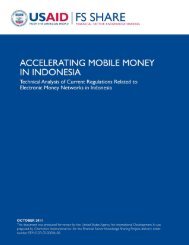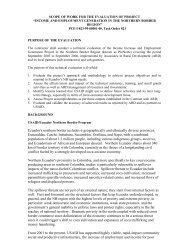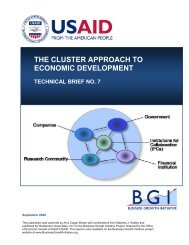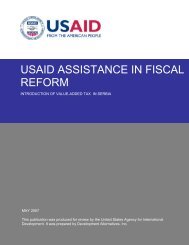Afghanistan's Agenda for Action - Economic Growth - usaid
Afghanistan's Agenda for Action - Economic Growth - usaid
Afghanistan's Agenda for Action - Economic Growth - usaid
You also want an ePaper? Increase the reach of your titles
YUMPU automatically turns print PDFs into web optimized ePapers that Google loves.
Afghanistan’s <strong>Agenda</strong> <strong>for</strong> <strong>Action</strong>: Developing the Trade & Business Environment – August 2007the math on the competing opportunities be<strong>for</strong>emaking their decision. Macedonia is advertising in majorWestern newsmagazines: 10% business tax and 24/7electricity. Plus, no war.B. The Telecom Model – a Promise <strong>for</strong> theDevelopment of ElectricityTelecommunications in Afghanistan exist in a worldseparate from almost everything else. TheTelecommunications Services Regulation Act 145 creates<strong>for</strong> the telecom industry all of those implementing andsupporting institutions that are necessary to it but thataren’t available on the broader market. There is aregulating body with simple transparent mandates thatdon’t suggest or implicate any broader powers. Thereis a clearly defined mechanism <strong>for</strong> grievance andadjudication, en<strong>for</strong>cement and compensation – allcontained within the telecom regime and not touchingor concerning any of the courts. There is clearprovision <strong>for</strong> <strong>for</strong>eign investment and participation intelecom and there is little concern about intrusion bythe Investment Law since telecoms, having establishedtheir own legal regime of apparent sufficiency, areexempted from it. In 32 pages, the Telecom Actsuccinctly anticipates major current and futurecontingencies, creates a TelecommunicationsDevelopment Fund, separates the roles of policymakerand implementer of the telecom regime, and establishesrules to mitigate the effects of monopolistic behaviorby major market participants. The government doeshave a vestigial but small stake in the market but ithasn’t appeared to stifle growth and competition. Afourth (multipurpose) license has been sold andwireless telecoms have already penetrated almost 10%of the prospective market. Phone card sellers in Kabuloutnumber fire hydrants and <strong>for</strong>eign investors areresponsible <strong>for</strong> over 70% of the market in wirelesstelecoms.The telecom model succeeds by integrating itsinstitutional requirements that can’t be met elsewhere.This insulates it from the vagaries of various other lawdrafters, decree issuers and governmental nonper<strong>for</strong>mers.It remains an instrument of, and under145Telecommunication Regulation Services Act, available athttp://www.moc.gov.af/Documents/Policies%20and%20Laws-MoC/Telecom%20Law.pdf.more or less the full control of the government, butthe “package” deal gives investors predictability. Withpredictability, an enterprise can plan <strong>for</strong> profit. Ifelectricity is the most glaring critical gap in the road toeconomy-building <strong>for</strong>eign (and domestic) investment, itwould seem that fixing the energy sector would go along way to fixing the economy.Telecommunications and energy share significantsimilarities. They are both ubiquitous services thatserve to “glue” the rest of the economy together. Theyboth demand strategic behavior and investment that isfocused on the “long-goals” of infrastructuredevelopment and perpetual capacity growth. They areboth public services with significant political cache’. (Assuch, they both typically require a government hand to<strong>for</strong>ce providers to serve customers who are notprofitable in the name of “the public good.”) Theirnature and structure lends neither to having a largenumber of market participants and their services are amatter of national pride.A number of significant hurdles need to be overcome ifthe Afghan telecom model is to be applied to thegrowth and development of its energy sector. Thegovernment must commit itself to partnerships withprivate enterprises that hold the necessary capital andtechnical expertise. Next, the production and deliveryof energy needs to be adequately monetized. There area number of steps inherent in this one, namely,adequate valuation of services, accurate accounting ofservices delivered, protection from onerous fees andduties by the government (or at least a provision <strong>for</strong>plowing those fees back into the energy sector – eitherthrough or by bypassing the Treasury), and protectionfrom nationalization and other political risk. 146Afghanistan lacks the capital, the expected futurerevenue, the technical expertise, and the ability tocommit to a strategic plan (without politicalinterference) necessary to develop its energy sector.Short-term contracts to build capacity piece-by-piecewon’t get the job done because they aren’t be able to146History has shown that while nascent governmentsrarely think they can run the nuts and bolts of their owntelecom sector, they often believe they can take chargeof energy production and distribution in its entirety.103


